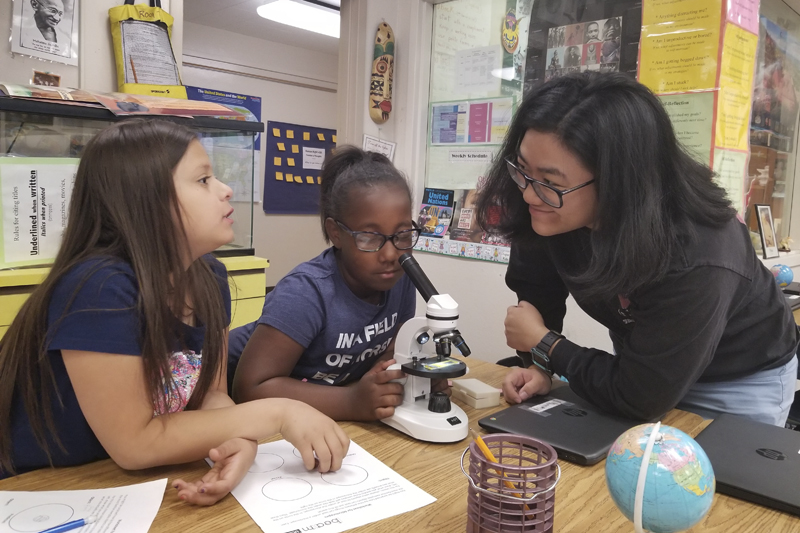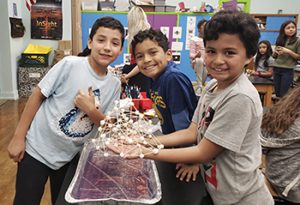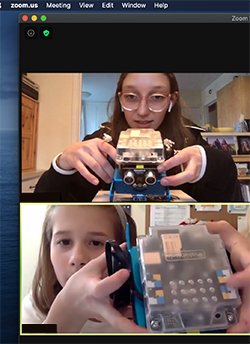UCLA Students Offer Underserved K-8 Students Hands-on STEM Lessons

COVID-19 has not stopped UCLA student organization Building Engineers and Mentors (BEAM) from bringing hands-on, complimentary STEM lessons and activities to underserved K-8 schools across Los Angeles. In fact, BEAM stepped up its efforts in serving students from lower-income families and underrepresented groups that have little or no access to quality STEM education.
Similar to the students they serve, BEAM members come from a variety of backgrounds. Nineteen of BEAM’s 28 active members are engineering students, whereas the remainder are split between life sciences and physical sciences majors. From freshmen to seniors, each BEAM mentor has had prior experience working with children and shares a deep passion for science education.
BEAM President Laurel Woods, a third-year computer science and cognitive science student, says she was immediately drawn to BEAM at an engineering club fair during her freshman year. Her passion for using technology for social good and her rewarding past experience as a math tutor resonate strongly with BEAM’s mission of sharing the wonders of STEM at underserved schools.
“Growing up, I had the privilege of being exposed to STEM fields from a young age, but many other students don’t,” Woods explained. “Elementary school is a critical period when students develop their interests and we can make a real impact by showing them how STEM can be fun and creative.” Second-year materials science and engineering student and BEAM Vice President Kara Levy finds that BEAM is often the “crucial turning point to push these young students into STEM” because of the deep connections students make with their mentors and their ability to engage with fun, hands-on activities involving slime, lava lamps and even rockets.
 Prior to the safer-at-home order resulting from the pandemic, BEAM members visited two Los Angeles Unified School District elementary schools, Melrose and Crescent Heights, each week for an hour-long lesson. As BEAM transitioned to remote instruction, its members dropped off school supplies for about 15 students and successfully launched a four-week virtual pilot program over the summer. Prior to the start of the fall quarter, BEAM recruited new members to help adapt old lesson plans so they can be taught effectively in a virtual format. This quarter, BEAM was able to purchase and send to students 30 new mBots, small programmable robots designed for youth education.
Prior to the safer-at-home order resulting from the pandemic, BEAM members visited two Los Angeles Unified School District elementary schools, Melrose and Crescent Heights, each week for an hour-long lesson. As BEAM transitioned to remote instruction, its members dropped off school supplies for about 15 students and successfully launched a four-week virtual pilot program over the summer. Prior to the start of the fall quarter, BEAM recruited new members to help adapt old lesson plans so they can be taught effectively in a virtual format. This quarter, BEAM was able to purchase and send to students 30 new mBots, small programmable robots designed for youth education.
While Rebecca Remple is not an engineering major, the second-year biology student and BEAM secretary says she “fell in love with the unique and valuable service BEAM provides to the LA community by helping students develop critical thinking skills and a passion for sciences.”
BEAM also partnered with ACM Teach LA, a student organization that provides free computer science classes to Los Angeles-area schools. Together, they developed block-based Scratch programming lessons for BEAM students to explore coding.
 For the fall quarter, BEAM planned 12 virtual site visits for the 45 students at Melrose and Crescent Heights. Within a few weeks, however, mentors noticed some obstacles in remote instruction— technical issues, students not turning on their cameras and lack of workspace in student homes. Rather than feel discouraged, the mentors rose to the challenge and improved the learning experience through effective communication, regular check-ins and utilizing Zoom breakout rooms. Two mentors were paired with three to four students, allowing deeper connections with their students and providing more individualized attention. Despite the initial difficulties, BEAM administrators actually found the virtual format helpful in recruiting more members, with greater scheduling flexibility and hands-on, parent-student bonding opportunities. Most importantly, there is no longer a need to worry about transportation time or costs.
For the fall quarter, BEAM planned 12 virtual site visits for the 45 students at Melrose and Crescent Heights. Within a few weeks, however, mentors noticed some obstacles in remote instruction— technical issues, students not turning on their cameras and lack of workspace in student homes. Rather than feel discouraged, the mentors rose to the challenge and improved the learning experience through effective communication, regular check-ins and utilizing Zoom breakout rooms. Two mentors were paired with three to four students, allowing deeper connections with their students and providing more individualized attention. Despite the initial difficulties, BEAM administrators actually found the virtual format helpful in recruiting more members, with greater scheduling flexibility and hands-on, parent-student bonding opportunities. Most importantly, there is no longer a need to worry about transportation time or costs.
While BEAM members are thrilled to continue outreach remotely, they are keenly aware there remains more to be done. From her own experiences as a woman in STEM, Woods says she knows it will take persistent efforts to make the industry more diverse and inclusive.
In order to provide more accessible educational resources and expand service to more schools, BEAM will create its own YouTube channel of recorded lessons and activities involving common household items. BEAM plans to add a third school in its outreach effort and the organization’s longer-term goals are to improve recruitment and retention efforts of students in engineering and other higher-education STEM programs.
Woods says BEAM will do its part to play an active role in creating a more welcoming environment in the field of STEM for aspiring young scholars of all backgrounds and identities. “Many of the students we mentor may not know any scientists or engineers in their life,” she said. “It’s our goal to show young students that engineering is fun and creative.”
UCLA Samueli School of Engineering is proud to support initiatives and programs, such as BEAM, that are designed to make the engineering community more equitable, diverse and inclusive. If you are interested in joining the efforts, please consider contributing to BEAM.
Sarah Wang contributed to this story.
